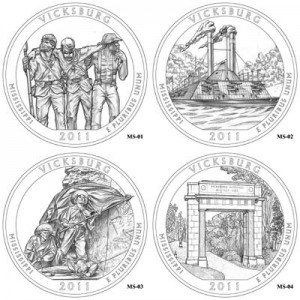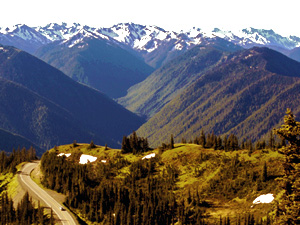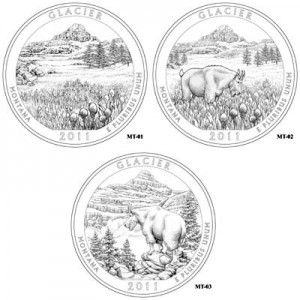December 9, 2010 – 1:30 pm

U.S. Mint art for the top contenders for the Vicksburg National Military Park quarter design.
The U.S. Mint presented four finalist designs for the 2011 Vicksburg National Military Park quarter to the Citizens Coinage Advisory Committee, the Commission of Fine Arts, the Secretary of the Interior, and the state of Mississippi for consideration. Vicksburg and the park are located on a prominent bend of the Mississippi River, and the capture of Vicksburg by Union military and naval forces was a pivotal event of the Civil War.
The Citizens Advisory group favored design #2 depicting the Union ironclad U.S.S. Cairo – recommending its “virtue of showcasing the historical significance of the Navy in the Civil War,” as well as the importance of the Mississippi River throughout the conflict. The Commission of Fine Arts supported #4 featuring Memorial Arch at the entrance to the park. The Commission discouraged the use of the partial sculptures or memorials seen in designs #1 and #3 as not being easily recognizable features to those familiar with or visiting the park.
After receiving input from all required entities, the Director of the U.S. Mint will make final recommendations to the Secretary of the Treasury – who will make the final design decision.
December 9, 2010 – 12:46 pm

Soldiers’ Rest Cemetery, Vicksburg (NPS photo)
Strategically located on the Mississippi River, Vicksburg was the site of a pivotal Civil War siege by Union General Ulysses S. Grant from May 18 to July 4, 1863. The surrender of Vicksburg, MS (coupled with the fall of Port Hudson, LA a week later) gave control of the Mississippi River to Union forces and effectively split the Confederacy in half. This hard-fought turning point of the Civil War was commemorated in 1899 with establishment of the Vicksburg National Military Park – featured on the 9th design (and fourth 2011 issue) of the America’s National Park Quarter series.
Museum exhibits at the park depict the hardships of civilians and soldiers during the devastating 47-day siege of the city. The park’s 16-mile tour road features more than 1,350 historic monuments and markers, 20 miles of reconstructed trenches and embankments, over 140 emplaced Civil War cannons, and the restored Union ironclad gunboat U.S.S. Cairo. Encompassing about 1,728 acres, the park runs along the boundaries of the city of Vicksburg, includes most of the original battlefield, and provides important open space, shade trees, and wildlife habitat for the metropolitan area.
The Park Service also manages and maintains the Vicksburg National Cemetery – final resting place for more than 17,000 Civil War soldiers and sailors.
More information on Vicksburg National Military Park.
November 29, 2010 – 12:12 pm

U.S. Mint art for the top contenders for the Olympic National Park quarter design.
Four designs for reverse of the 2011 Olympic National Park quarter were submitted to the Citizen’s Coinage Advisory Committee early in 2010. The committee viewed four designs and selected the one with a Roosevelt elk about to cross the Hoh River with Mt. Olympus in the background. Members also liked the design featuring a coastal view with the ocean and sea stacks in the distance. The two landscape themes received the least number of votes.
Olympic National Park is the nation’s 6th largest park with over 922,000 acres of forest, meadows, mountains and coastlines. With over 600 miles of trails, it is a hiker’s paradise. Whether it’s a visit to the lush, green Hoh Rainforest, the short hike to the Sol Duc Falls or a stroll along 73 miles of coastal beaches, this amazing park has something for everyone. The small town of Forks, a gateway to the park’s northwestern region, serves as the setting for the popular Twilight books.
November 29, 2010 – 12:03 pm

The road to Hurricane Ridge in Olympic National Park
Washington’s Olympic National Park is 1,441 sq. miles and includes miles of coastal beaches, old growth forests and glacial mountain peaks. Because of its old growth woodlands, the park serves as a refuge for many endangered species. It is one of the last large tracts of primeval forest in the lower 48 states.
In 1897, this beautiful park became the Olympic Forest Reserve. Later, because less than 200 of the area’s native elk herd remained, Teddy Roosevelt made it a national monument in 1909 to protect these animals. The elk then became known as Roosevelt elk. Finally, in 1938 Congress made it a national park.
At the heart of this magnificent park are most of the Olympic Mountains, with the 7,965 ft Mount Olympus at the center. Winds off the Pacific bring the western slopes of the mountains over 160 inches of rain a year, and averages of 250 to 500 inches of snow in the winter. Because of this, there are over 260 glaciers in the park’s mountain peaks. Olympic National Park offers visitors distinctive geography created by glaciers, lush rainforests, and many hiking and camping opportunities.
More information on Olympic National Park.
November 22, 2010 – 11:42 am

U.S. Mint art for the top contenders for the Glacier National Park quarter design.
Early in 2010, the Citizens Coinage Advisory Committee reviewed three candidate designs for reverse of the 2011 Glacier National Park quarter. For the first time ever, the committee gave its highest marks to the designs for Glacier National and Olympic National Parks. The favored Glacier designs show a mountain goat in the foreground with a towering peak in the background. The mountain goat is the park’s official symbol.
All of Glacier National Park is in northern Montana along the Continental Divide, and is the 5th largest U.S. national park, covering over 1 million acres. It became protected as a forest preserve in 1897, and a park during the presidency of William Howard Taft. In 1932 through the efforts of Rotary Intl., the park joined with Canada’s Waterton Lakes National Park to become Waterton-Glacier International Peace Park, honoring the long-standing friendship between the two countries.
Whether it’s the mountain goats against a dramatic backdrop, or a majestic mountain peak, each candidate design captures the geological features and rich history associated with Glacier National Park.





